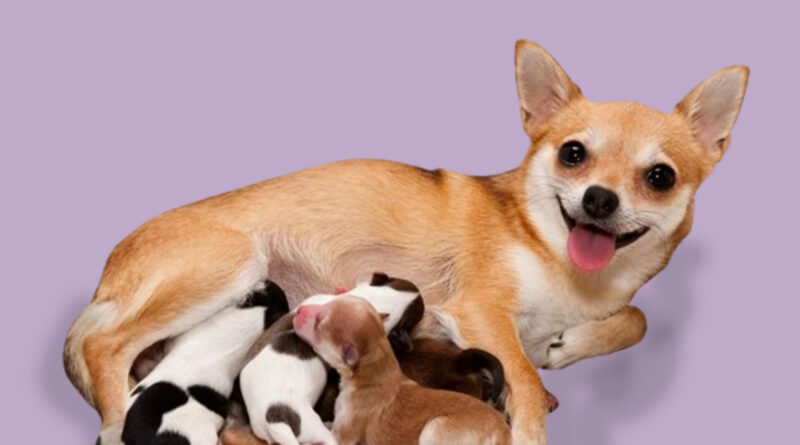Dog Pregnancy Signs Week By Week and Symptoms to Watch 2024

For dog owners, welcoming a litter of pups into the world is a joyful and fulfilling event. Knowing the Dog Pregnancy Signs Week By Week is essential to giving the expecting mother and her future puppies the best care possible. We shall examine the many phases of canine pregnancy in this extensive guide, outlining the morphological and behavioral changes that take place from the first week of pregnancy until delivery.
Weeks 1-2: Early Development and Conception
Physical changes are minor, and there are hardly any visible symptoms during the first two weeks of pregnancy. Nonetheless, because fertilization and early cell division are occurring during this time, it is crucial. Even though there might not be any obvious symptoms at this point, it’s still crucial to make sure the mother is given the right nourishment and attention to assist the growing embryos.
Weeks 3-4: Early Hormonal Changes and Implantation
Physical changes are minor, and there are hardly any visible symptoms during the first two weeks of pregnancy. Nonetheless, because fertilization and early cell division are occurring during this time, it is crucial. Even though there might not be any obvious symptoms at this point, it’s still crucial to make sure the mother is given the right nourishment and attention to assist the growing embryos.
Weeks 3-4: Early Hormonal Changes and Implantation
The mother’s body undergoes hormonal changes when the fertilized eggs implant in the uterine lining around the third week. Subtle behavioral changes, such as greater affection or mild changes in hunger, may result from these changes. Although there aren’t any noticeable physical changes yet, some owners may notice a modest weight gain.
Weeks 5-6: Notable Physical Changes
The fifth and sixth weeks of pregnancy are when the physical changes that occur as the embryos grow into fetuses are most noticeable. Owners could notice a small belly bulge as well as an increase in appetite. Additionally, the nipples may shift, growing bigger and more noticeable. During this phase, a veterinarian can use ultrasound or other diagnostic procedures to confirm the pregnancy.
Weeks 7-8: Unmistakable Pregnancy Symptoms
As the expanding fetuses take up more space, the dog’s abdomen gets notably enlarged by the seventh week. The mother might start acting like she’s nesting, and owners might notice a further rise in hunger. The nipples keep growing and might even get darker in color. Now is the critical moment to feed the mother a healthy diet to help the pups as they grow.
Weeks 9-10: Getting Ready for Work
The woman has noticed an increase in abdominal distention as the due date draws near. She might get more agitated and look for a peaceful, cozy area to give birth. Nesting behavior becomes more intense; therefore, owners should provide the expectant mother with a comfortable and peaceful place. The woman may have less appetite in week 10 as she gets ready for labor.
Delivery and Labor:
On or about day sixty-three, the mother goes into labor. Constraints, panting, and restlessness are among the symptoms. Puppy deliveries can take several hours, with each puppy arriving on its own. A peaceful and encouraging environment is crucial, and owners should be ready to help out if needed. In case of difficulties, a veterinarian should be contacted right away.
Major Signs of Dog Pregnancy Signs Week By Week
It’s always a thrilling concept to bring a new life into your home, and if you own a dog, the thought of your best friend becoming pregnant makes it much more exciting. Dog Pregnancy Signs Week By Week Dogs experience unique changes during pregnancy, just like people do, and it is important to recognize the symptoms and indicators for the sake of your dog’s health and wellbeing. In this post, we’ll look at ten major signs your dog is pregnant, giving you important information about the fascinating process of a dog becoming pregnant.
1. Modifications in Behavior:
Dogs during pregnancy often display a range of emotional changes, including enhanced affection, restlessness, reduced energy, increased sensitivity, changes in playfulness, and seclusion. dog pregnancy signs week by week may exhibit signs of restlessness, such as pacing or agitation, due to their natural desire to nest or pregnant pain. As their bodies adjust to support developing pregnancies, they may feel a decrease in energy, leading to a more laid-back mindset. Pregnancy hormones may increase sensitivity to their surroundings, causing intense reactions to sights, sounds, and changes in behavior. Some dogs may lose interest in games or activities they used to enjoy as a reaction to internal physiological changes. Dog Pregnancy Signs may also long for solitude, as they prefer a safe, peaceful area for rest and nesting. It is crucial to recognize these behavioral changes to spot early pregnancy symptoms and provide the necessary attention and support for your furry friend during this transformational period.
2. Curiosity Variations:
Dog Pregnancy Signs Week By Week involves hormonal changes that can alter their eating habits. Some dogs may show decreased appetite due to hormonal fluctuations or mild nausea, while others may have increased appetite due to the body’s need for nutrients. It’s crucial to monitor these changes and ensure your dog is consuming enough nutrition to support both themselves and their developing fetuses. Dog Pregnancy Signs Week By Week may develop specific food preferences, such as protein-rich foods or softer textures, which can be tailored to their evolving nutritional needs. Some may adopt snacking or grazing habits, which can be accommodated by adjusting feeding routines. Water intake is also crucial during dog pregnancy signs, and any significant increase or decrease should be addressed promptly. Understanding your dog’s changing appetite is crucial for providing optimal care, and regular monitoring and a balanced diet can ensure your dog receives the necessary nutrients for a healthy pregnancy. Consultation with a veterinarian can provide personalized guidance on dietary adjustments.
3. Changes in the Mammary Gland and Nipple:
Dog Pregnancy Signs Week By Week, dogs’ nipple area undergoes significant changes, including enlargement, color change, swelling, tenderness, visible veins, and proliferation of mammary tissue. These changes are not only cosmetic but also necessary for the upcoming maternal responsibilities. The nipples may become larger and more pronounced, resulting from hormonal changes as the body prepares for milk production. The color of the nipples may shift, with lighter-colored dogs showing more noticeable changes due to increased blood flow to the mammary glands. Mammary glands may also experience swelling and feel fuller to the touch as the body prepares for lactation and nursing. Tenderness and increased sensitivity around the nipple area are also common, making it essential to handle the area gently. Regular monitoring of these changes is crucial for the well-being of both the expectant mother and her future litter.
4. Changes in body weight and shape:
Dog Pregnancy Signs Week By Week is a natural and expected transformation of a pet’s body, involving weight gain, rounding of the abdomen, changes in body proportions, visible swelling of mammary glands, a shift in back profile, increased girth, and potential changes in coat texture. Weight gain is a natural occurrence due to the developing fetuses, amniotic fluid, and increased blood volume. The rounding of the abdomen is the most visible sign of pregnancy, as the abdomen expands to accommodate the growing puppies. Changes in body proportions, such as elongation and rounding of the abdomen, are also observed. Mammary glands also undergo visible swelling, gearing the body for nursing the puppies. The back profile shifts due to the developing fetuses and expanding uterus. The circumference of the abdomen increases, indicating the dynamic processes happening within the dog’s body. Some pregnant dogs may undergo subtle changes in coat texture, influenced by hormonal fluctuations. Regular veterinary checkups provide guidance on adjusting diet and exercise routines.
5. Increasing Water Usage:
Dog Pregnancy Signs Week By Week is a time of significant physiological changes, resulting in increased water intake for both the expectant mother and her developing litter. This increased thirst is crucial for maintaining the health and well-being of the expectant mother, supporting amniotic fluid formation, meeting the demands of milk production, and regulating body temperature. The increased thirst helps compensate for physiological changes, such as increased blood flow and fluid retention, which can lead to dehydration if not counteracted by sufficient water intake. Regular monitoring of water intake is essential to detect any abnormalities and seek prompt veterinary attention if needed. Ensuring your pregnant dog has constant access to fresh and clean water is essential for supporting these increased hydration needs. Regular veterinary check-ups provide an opportunity to discuss and monitor water intake, allowing you to actively contribute to the well-being of your expectant canine companion. By understanding and accommodating her heightened thirst, you play a pivotal role in facilitating a healthy pregnancy journey.
6. Vaginal Fluid Outflow:
Dog Pregnancy Signs Week By Week can lead to changes in vaginal discharge, which is an inherent part of the reproductive process. Clear or slightly cloudy discharge, often mucoid, is a common occurrence during the fourth week of pregnancy, coinciding with embryo implantation and gestation. Increased blood flow to reproductive organs contributes to the production of mucoid discharge, serving as a protective element for the birth canal. Monitoring for abnormalities, such as foul-smelling or discolored discharge, is crucial. Pregnancy-related discharge is generally subtle and mucoid, unlike estrus discharge. Excessive discharge or continuous dripping may be cause for concern, and consulting a veterinarian is recommended to rule out any complications.
7. Modification of Sleeping Habits:
Dog Pregnancy Signs Week By Week involves hormonal and physical changes that influence their daily lives, including their sleeping habits. Pregnant dogs often experience an increased need for rest, restlessness during sleep, preference for comfortable spaces, more frequent waking, affectionate sleeping positions, nesting behaviors, and increased daytime napping. These changes reflect the nurturing instincts emerging as the pregnancy progresses and provide a supportive environment for the expectant mother and her newborn litter. Understanding and accommodating these changes is crucial for providing a positive and stress-free pregnancy experience and ensuring the well-being of both the expectant mother and her litter. By recognizing and honoring these maternal instincts, you play a crucial role in ensuring the well-being of both the expectant mother and her litter. soon-to-be-born litter.
8. Morning Tiredness:
Morning sickness, a common occurrence in dogs during pregnancy, is a normal part of the early stages of pregnancy. It is often manifested through mild and sporadic episodes of vomiting, which are influenced by hormonal changes and physical adjustments. This condition is not a persistent or severe one, but rather a normal part of the early pregnancy experience. To manage the symptoms, pet owners should provide adequate nutrition, consult with a veterinarian if the vomiting becomes persistent, and ensure their dog is well-hydrated. Maintaining open communication with a veterinarian is crucial for addressing any concerns or complications, contributing to a positive pregnancy journey for both the expectant mother and her puppies.
9. An expansion of the abdomen:
Dog Pregnancy Signs Week By Week display a significant change in their abdomen, indicating their pregnancy. This change is a result of gradual expansion, visible rounding, and palpable swelling. The size of the litter and breed-specific traits can influence the expansion rate and degree of the abdomen. Dog Pregnancy Signs Week By Week require a balanced diet and exercise to maintain overall health and a comfortable pregnancy. Regular veterinary examinations are crucial to track the pregnancy’s development and evaluate the health of the expecting mother and her offspring. A veterinarian can offer advice on modifying diet, exercise routine, and lifestyle choices to ensure a healthy pregnancy. The larger abdomen also signifies the approaching whelping or birthing process, as the puppies are getting closer to reaching full term in the uterus. Pregnant dogs’ larger abdomens serve as a reminder of the amazing canine pregnancy and the importance of active involvement in their prenatal care.
10. Nesting Patterns:
Dogs exhibit nesting behavior during pregnancy, reflecting their natural maternal instincts. This behavior involves collecting resources, digging and scratching, positioning and restlessness, and putting together bedding to create a safe and cozy space for the upcoming puppies. Pregnant dogs have protective instincts, preferring quiet environments to care for their puppies. They may also vocalize more than usual, using it as a communication tool. Some dog owners build a “birth box” to encourage nesting behavior by providing soft bedding and a calm environment. Respecting the nesting space is crucial to preventing unnecessary disturbances and ensuring the designated space is secure and convenient. Consultation with a veterinarian is advised if nesting behavior becomes overly fixated or if there are issues with the chosen area. Acknowledging and embracing these instincts can help create a stress-free environment for the expectant dog and heighten the excitement of her upcoming puppies’ arrival.
Conclusion
It’s crucial to recognize the telltale signs and symptoms of a Dog Pregnancy Signs Week By Week in order to give your pet the best care possible. Throughout your pregnancy, it’s imperative that you have routine check-ups with your veterinarian and maintain open contact with them. You can make sure that your dog has a smooth and healthy pregnancy and welcomes a happy litter of lovely puppies into your home by keeping an eye out for these ten crucial signs.




